Olympus 35RD: Shutter and Aperture blade cleaning
by Henry Taber

|
This camera is Larry Humphrey's. A generous friend of mine
who was gracious enough to let me use his camera for this article. All
I had to do in return was clean the blades. He is a local camera collector
and the nice guy who sold me my first Leica. And GAVE me my first two
Contax's!
This 35RD is a pretty nice specimen with the classic oily aperture and
shutter blade syndrome.
If the front element assembly isn't too tight this is an excellent first
project for a newbie. It is very simple and straightforward. Also neither
the top or bottom covers need be removed.
|

|
Notice the nice, clean...and un-oily...shutter blades.
This is because I didn't decide to take the photographs and write the
article until after the lens was mostly disassembled. So what you will
be seeing is the reassembly photos with disassembly instructions.
With pencil point lens spanners, machinist dividers or your favorite
"weapon of mass destruction" unscrew the thin, slotted ring
around the nameplate bezel. Desoldering the sensor wires at the sensor
will make disassembly easier. This camera had been previously opened and
the black and red wires to the sensor were cut and resoldered. So if you
choose that method, don't blame me for the hassle of trying to solder
two wires back together while they are dangling in the air. I desoldered
at the sensor! Polarity doesn't matter in resoldering.
Next, remove the three screws holding the ASA and shutter speed detent
ring. (blue arrows) Be very careful when
lifting the shutter speed dial because the detent ball will fall out.
(green arrow)
|
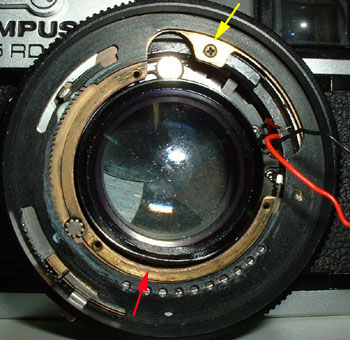 |
It is a good idea to work on a washcloth so any piece that
falls out won't roll off the desk. Also with the cloth you won't scratch
up the camera as you move it around on the desk.
Clean all oily parts with Ronsonol as they are disassembled. My favorite
method is holding cut Kleenex or folded bits of lintless cloth in locking
tweezers.
Remove the four screws holding the brass disc. (yellow
arrow) The other three are under the shutter speed dial.
When reassembling the shutter speed dial, place the dial in engagement
with the splined shaft and carefully turn all the way clockwise. Reposition
the dial if end of gear rack is reached. Set the shutter speed dial to
500. After mounting the outer retainer recheck that all speeds work...especially
the B. You should hear a slight buzz on B as the shutter closes. |
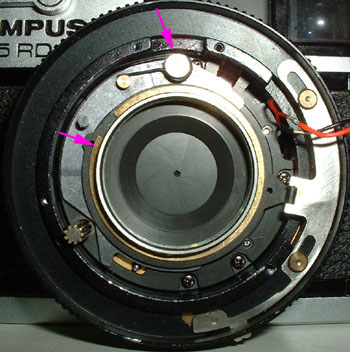 |
Removing the front element assembly was VERY difficult
on this camera. Hope yours is easier to loosen. Even though I made a custom
fitting tool this one was so tight the slots on the brass ring mount stripped.
After several futile attempts finally it took a hammer and drift as well
as my brother-in-law, Bob, helping to finally get it off.
There was some deformation damage on the retaining shroud around the
glass but no functional damage to the lens. I figured this is where the
previous repair attempt had been stopped. Sorry Larry, other than this,
I left no other mark. (red arrow) The sign
of a good repair is if one can't tell there was a repair.
With a thin screwdriver gently pry up the brass retaining ring and remove
the ring below it. (left magenta arrow)
Remove the spring, unscrew the shoulder screw and remove the curved arm.
(upper magenta arrow)
|
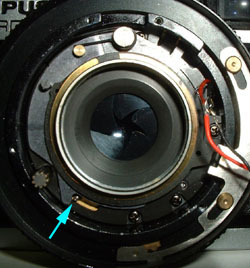 |
Here's a picture of the oily shutter blades. Notice how
they are partially opened. The oily aperture is stuck open at f/1.7. It
should be spring loaded closed. In the previous photo the cleaned aperture
is at f/16. The aperture opens as the shutter button is depressed.
Observe the different positions of the aperture pin. (light
blue arrow) |
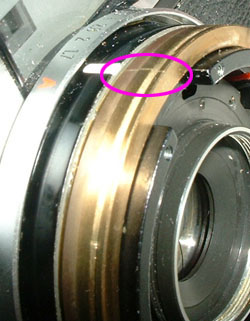 |
The focus ring must be removed before the aperture/shutter housing can
be extracted. The forked, crescent shaped metal piece on the focus ring
prevents aperture/shutter housing removal.
Turn the focus ring to infinity then loosen (no need to remove) the four
setscrews around the rings outside perimeter. Carefully remove the focus
ring, being sure to not move it off of infinity, and scratch a mark on
the brass outer helix at infinity. Make the mark very accurate! With it
marked accurately we won't have to readjust the infinity focus. (magenta
ellipse)
Do not remove the two tiny crosspoint screws in
the focus ring. They are for the ring's limit stops. The focus ring slips
off with the stop attached after the setscrews are loosened.
|
 |
Here is the oily aperture at f/16 and the focus ring removed.
The aperture/shutter housing takes some wiggling to get it free.
Don't force anything. It'll come out easily once it gets free. It takes
even more wiggling going back in. If there is a trick to make it easier
to reassemble, I didn't learn it. But I do know the shutter blades need
to be in the closed position and the splined shaft turned until it engages.
Notice all six screws around the perimeter are removed. Do not remove
all six now. Only remove three...see next photo.
|
 |
The Aperture/Shutter housing is held together with three
screws and the housing is mounted into the lens with the three other screws.
The big question is which are which. I removed all six and everything
fell out in a heap. You won't need to have that frustration. In the picture
the three screws holding the housing halves together are installed. (orange
arrows)
Remove the other three screws (that are shown already removed) to extract
the housing intact. |
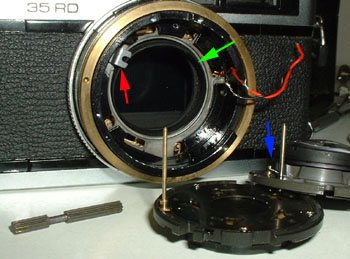 |
If you remove all six screws (like I did) everything falls
out and you don't get to study how everything was assembled.
Gently unhook the spring from the brass stop. (blue
arrow) You can leave the spring hooked to the tall
shaft. To get to the blades NOW unscrew the screws with the orange arrows.
The light-tighting shroud for the rear element is loose. Don't bend it
or crush it during reassembly. (green arrow)
Shutter activation arm. (red arrow) This
arm opens AND closes the shutter blades. Cocking and releasing with the
shutter out, to see how it works, doesn't mess anything up. |
 |
The aperture blades are retained by three screws and the
plate shown on the right. Notice the oily, stuck together shutter blades
in the background. We'll get to them soon.
Try not to touch the blades and their mating surfaces with your fingers.
Use tweezers and dental tools to hold and move them around while cleaning. |
 |
Here are the shutter blades, all clean and ready to be
assembled. First place the rotator ring onto the rear housing (shown already
on the rear housing, magenta arrow) then
the large round disk and finally the blades themselves. Notice there are
six blades in this five blade shutter. The first and last blades are mounted
in the same location.
The assembled front aperture housing is in the background.
|
 |
Now with both aperture and shutter blades in their respective
housings the two halves can be reassembled.
The shutter blades don't go between the rotator ring and the large disc,
although it looks like they should. Rather they fit on top of the large
disc and are sandwiched between the two housings. |
 |
Don't forget to reattach the aperture spring on the far
side of the housing. Also the spline shaft that operates the shutter speeds
has to be installed into the open slot in the lower left corner of the
housing before installing the housing into the lens cavity. The shaft
is shown mounted into the cavity first, but that was just to check fit.
The long spline end goes into the body.
Now you get to reassemble everything in reverse order. |
|